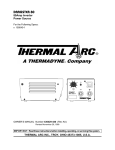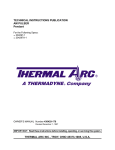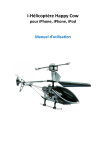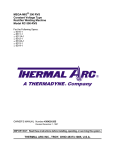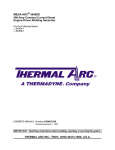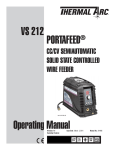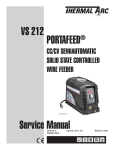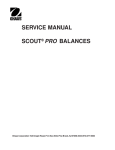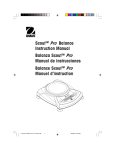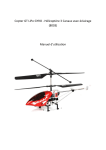Download Thermal Arc SP 2001 Spool Gun Assembly Owner`s Manual_
Transcript
SP-2001 SPOOL GUN ASSEMBLY For the Following Specs: • 407838B-1 — SP-2001 Spool Gun with 50 Ft. Cable Assembly • • • 407838B-2 — SP-2001 Spool Gun with 25 Ft. Cable Assembly • OWNER’S MANUAL Number 430429-287 Revised April 6, 1998 IMPORTANT: Read these instructions before installing, operating, or servicing this system. THERMAL ARC INC., TROY, OHIO 45373-1085, U.S.A. 430429-287 TABLE OF CONTENTS INTRODUCTION 1 How To Use This Manual . . . . . . . . . . . . . . . . . . . . . . . . . . . . . . . . . . 1-1 Equipment Identification . . . . . . . . . . . . . . . . . . . . . . . . . . . . . . . . . . 1-1 Receipt Of Equipment . . . . . . . . . . . . . . . . . . . . . . . . . . . . . . . . . . . 1-1 ARC WELDING SAFETY INSTRUCTIONS AND WARNINGS 2 DESCRIPTION OF EQUIPMENT General . . . . . . . . . . . Product Specifications . . . Spool Gun Components . . Power Source Compatibility INSTALLATION . . . . . . . . . . . . 3 . . . . . . . . . . . . . . . . . . . . . . . . . . . . . . . . . . . . . . . . . . . . . . . . . . . . . . . . . . . . . . . . . . . . . . . . . . . . . . . . . . . . . . . . . . . . . . . . . . . . . . . . . . . . . . . . . . . . 3-1 3-1 3-1 3-2 4 Overview . . . . . . . . . . . . . . . . . . . . . . . . . . . . . . . . . . . . . . . . . . 4-1 Connections . . . . . . . . . . . . . . . . . . . . . . . . . . . . . . . . . . . . . . . . . 4-1 OPERATION 5 Prewelding Procedure . . . . . . . . . . . . . . . . . . . . . . . . . . . . . . . . . . . 5-1 Welding Procedure . . . . . . . . . . . . . . . . . . . . . . . . . . . . . . . . . . . . . 5-1 PARTS LIST 6 Equipment Identification . . . . . . . . . . . . . . . . . . . . . . . . . . . . . . . . . . 6-1 How To Use This Parts List . . . . . . . . . . . . . . . . . . . . . . . . . . . . . . . . . 6-1 DIAGRAMS April 6, 1998 Revised 430429-287 INTRODUCTION INTRODUCTION How To Use This Manual: Equipment Identification: This Owner’s Manual usually applies to just the underlined specification or part numbers listed on the cover. If none are underlined, they are all covered by this manual. The unit’s identification number (specification or part number), model, and serial number usually appear on a nameplate attached to the machine. Equipment which does not have a nameplate attached to the machine is identified only by the specification or part number printed on the shipping container. Record these numbers for future reference. To ensure safe operation, read the entire manual, including the chapter on safety instructions and warnings. Throughout this manual, the words WARNING, CAUTION, and NOTE may appear. Pay particular attention to the information provided under these headings. These special annotations are easily recognized as follows: WARNING gives information regarding possible personal injury. Warnings will be enclosed in a box such as this. CAUTION refers to possible equipment damage. Cautions will be shown in bold type. NOTE offers helpful information concerning certain operating procedures. Notes will be shown in italics. October 27, 1997 Revised Receipt Of Equipment: When you receive the equipment, check it against the invoice to make sure it is complete and inspect the equipment for possible damage due to shipping. If there is any damage, notify the carrier immediately to file a claim. Furnish complete information concerning damage claims or shipping errors to Thermal Arc, Order Department, 2200 Corporate Drive, Troy, Ohio 45373-1085. Include all equipment identification numbers as described above along with a full description of the parts in error. Additional copies of this manual may be purchased by contacting Thermal Arc at the address given above. Include the Owner’s Manual number and equipment identification numbers. 1-1 ARC WELDING SAFETY INSTRUCTIONS AND WARNINGS Instruction 830001 ARC WELDING SAFETY INSTRUCTIONS AND WARNINGS ARC WELDING can be hazardous. PROTECT YOURSELF AND OTHERS FROM POSSIBLE SERIOUS INJURY OR DEATH. KEEP CHILDREN AWAY. PACEMAKER WEARERS KEEP AWAY UNTIL CONSULTING YOUR DOCTOR. DO NOT LOSE THESE INSTRUCTIONS. READ OPERATING/INSTRUCTION MANUAL BEFORE INSTALLING, OPERATING OR SERVICING THIS EQUIPMENT. Welding products and welding processes can cause serious injury or death, or damage to other equipment or property, if the operator does not strictly observe all safety rules and take precautionary actions. Safe practices have developed from past experience in the use of welding and cutting. These practices must be learned through study and training before using this equipment. Anyone not having extensive training in welding and cutting practices should not attempt to weld. Certain of the practices apply to equipment connected to power lines; other practices apply to engine driven equipment. Safe practices are outlined in the American National Standard Z49.1 entitled: SAFETY IN WELDING AND CUTTING. This publication and other guides to what you should learn before operating this equipment are listed at the end of these safety precautions. HAVE ALL INSTALLATION, OPERATION, MAINTENANCE, AND REPAIR WORK PERFORMED ONLY BY QUALIFIED PEOPLE. ELECTRIC SHOCK can kill. Touching live electrical parts can cause fatal shocks or severe burns. The electrode and work circuit is electrically live whenever the output is on. The input power circuit and machine internal circuits are also live when power is on. In semiautomatic or automatic wire welding, the wire, wire reel, drive roll housing, and all metal parts touching the welding wire are electrically live. Incorrectly installed or improperly grounded equipment is a hazard. 1. Do not touch live electrical parts. 2. Wear dry, hole-free insulating gloves and body protection. 3. Insulate yourself from work and ground using dry insulating mats or covers. 4. Disconnect input power or stop engine before installing or servicing this equipment. Lock input power disconnect switch open, or remove line fuses so power cannot be turned on accidentally. 5. Properly install and ground this equipment according to its Owner’s Manual and national, state, and local codes. ARC RAYS can burn eyes and skin; NOISE can damage hearing. Arc rays from the welding process produce intense heat and strong ultraviolet rays that can burn eyes and skin. Noise from some processes can damage hearing. 6. Turn off all equipment when not in use. Disconnect power to equipment if it will be left unattended or out of service. 7. Use fully insulated electrode holders. Never dip holder in water to cool it or lay it down on the ground or the work surface. Do not touch holders connected to two welding machines at the same time or touch other people with the holder or electrode. 8. Do not use worn, damaged, undersized, or poorly spliced cables. 9. Do not wrap cables around your body. 10. Ground the workpiece to a good electrical (earth) ground. 11. Do not touch electrode while in contact with the work (ground) circuit. 12. Use only well-maintained equipment. Repair or replace damaged parts at once. 13. In confined spaces or damp locations, do not use a welder with AC output unless it is equipped with a voltage reducer. Use equipment with DC output. 14. Wear a safety harness to prevent falling if working above floor level. 15. Keep all panels and covers securely in place. 1. Wear a welding helmet fitted with a proper shade of filter (see ANSI Z49.1 listed in Safety Standards) to protect your face and eyes when welding or watching. 2. Wear approved safety glasses. Side shields recommended. 3. Use protective screens or barriers to protect others from flash and glare; warn others not to watch the arc. 4. Wear protective clothing made from durable, flame-resistant material (wool and leather) and foot protection. 5. Use approved ear plugs or ear muffs if noise level is high. Eye protection filter shade selector for welding or cutting (goggles or helmet), from AWS A6.2-73. Filter Electrode Size Shade Welding or Cutting Metal Thickness No. Operation or Welding Current 2 Torch soldering — 3 or 4 Torch brazing — Oxygen cutting 3 or 4 Light Under 1 in., 25 mm 4 or 5 Medium 1 to 6 in., 25-150 mm 5 or 6 Heavy Over 6 in., 150 mm Gas welding 4 or 5 Light Under 1/8 in., 3 mm 5 or 6 Medium 1/8 to 1/2 in., 3-12 mm 6 or 8 Heavy Over 1/2 in., 12 mm 10 Shielded metal-arc welding Under 5/32 in., 4 mm 12 (stick) electrodes 5/32 to 1/4 in., 4 to 6.4 mm 14 Over 1/4 in., 6.4 mm May 8, 1996 Welding or Cutting Operation Gas metal-arc welding (MIG) Non-ferrous base metal Ferrous base metal Gas tungsten arc welding (TIG) Atomic hydrogen welding Carbon arc welding Plasma arc welding Carbon arc air gouging Light Heavy Plasma arc cutting Light Medium Heavy Electrode Size Metal Thickness or Welding Current Filter Shade No. All All All All All All 11 12 12 12 12 12 12 14 Under 300 Amp 300 to 400 Amp Over 400 Amp 9 12 14 2-1 ARC WELDING SAFETY INSTRUCTIONS AND WARNINGS Instruction 830001 FUMES AND GASES can be hazardous to your health. Welding produces fumes and gases. Breathing these fumes and gases can be hazardous to your health. 1. Keep your head out of the fumes. Do not breath the fumes. 2. If inside, ventilate the area and/or use exhaust at the arc to remove welding fumes and gases. 3. If ventilation is poor, use an approved air-supplied respirator. 4. Read the Material Safety Data Sheets (MSDSs) and the manufacturer’s instruction for metals, consumables, coatings, and cleaners. 5. Work in a confined space only if it is well ventilated, or while wearing an air-supplied respirator. Shielding gases used for welding can displace air causing injury or death. Be sure the breathing air is safe. 6. Do not weld in locations near degreasing, cleaning, or spraying operations. The heat and rays of the arc can react with vapors to form highly toxic and irritating gases. 7. Do not weld on coated metals, such as galvanized, lead, or cadmium plated steel, unless the coating is removed from the weld area, the area is well ventilated, and if necessary, while wearing an air-supplied respirator. The coatings and any metals containing these elements can give off toxic fumes if welded. WELDING can cause fire or explosion. 5. Watch for fire, and keep a fire extinguisher nearby. Sparks and spatter fly off from the welding arc. The flying sparks and hot metal, weld spatter, hot workpiece, and hot equipment can cause fires and burns. Accidental contact of electrode or welding wire to metal objects can cause sparks, overheating, or fire. 6. Be aware that welding on a ceiling, floor, bulkhead, or partition can cause fire on the hidden side. 1. Protect yourself and others from flying sparks and hot metal. 2. Do not weld where flying sparks can strike flammable material. 3. Remove all flammables within 35 ft (10.7 m) of the welding arc. If this is not possible, tightly cover them with approved covers. 4. Be alert that welding sparks and hot materials from welding can easily go through small cracks and openings to adjacent areas. FLYING SPARKS AND HOT METAL can cause injury. Chipping and grinding cause flying metal. As welds cool, they can throw off slag. CYLINDERS can explode if damaged. Shielding gas cylinders contain gas under high pressure. If damaged, a cylinder can explode. Since gas cylinders are normally part of the welding process, be sure to treat them carefully. 1. Protect compressed gas cylinders from excessive heat, mechanical shocks, and arcs. 2. Install and secure cylinders in an upright position by chaining them to a stationary support or equipment cylinder rack to prevent falling or tipping. 7. Do not weld on closed containers such as tanks or drums. 8. Connect work cable to the work as close to the welding area as practical to prevent welding current from traveling long, possibly unknown paths and causing electric shock and fire hazards. 9. Do not use welder to thaw frozen pipes. 10. Remove stick electrode from holder or cut off welding wire at contact tip when not in use. 11. Wear oil-free protective garments such as leather gloves, heavy shirt, cuffless trousers, high shoes, and a cap. 1. Wear approved face shield or safety goggles. Side shields recommended. 2. Wear proper body protection to protect skin. 3. Keep cylinders away from any welding or other electrical circuits. 4. Never allow a welding electrode to touch any cylinder. 5. Use only correct shielding gas cylinders, regulators, hoses, and fittings designed for the specific application; maintain them and associated parts in good condition. 6. Turn face away from valve outlet when opening cylinder valve. 7. Keep protective cap in place over valve except when cylinder is in use or connected for use. 8. Read and follow instructions on compressed gas cylinders, associated equipment, and CGA publication P-1 listed in Safety Standards. ENGINES can be hazardous. ENGINE EXHAUST GASES can kill. Engines produce harmful exhaust gases. 2-2 1. Use equipment outside in open, well-ventilated areas. 2. If used in a closed area, vent engine exhaust outside and away from any building air intakes. May 8, 1996 ARC WELDING SAFETY INSTRUCTIONS AND WARNINGS Instruction 830001 ENGINE FUEL can cause fire or explosion. Engine fuel is highly flammable. 1. Stop engine before checking or adding fuel. MOVING PARTS can cause injury. Moving parts, such as fans, rotors, and belts can cut fingers and hands and catch loose clothing. 1. Keep all doors, panels, covers, and guards closed and securely in place. 2. Stop engine before installing or connecting unit. SPARKS can cause BATTERY GASES TO EXPLODE; BATTERY ACID can burn eyes and skin. Batteries contain acid and generate explosive gases. STEAM AND PRESSURIZED HOT COOLANT can burn face, eyes, and skin. The coolant in the radiator can be very hot and under pressure. 2. Do not add fuel while smoking or if unit is near any sparks or open flames. 3. Allow engine to cool before fueling. If possible, check and add fuel to cold engine before beginning job. 4. Do not overfill tank — allow room for fuel to expand. 5. Do not spill fuel. If fuel is spilled, clean up before starting engine. 3. Have only qualified people remove guards or covers for maintenance and troubleshooting as necessary. 4. To prevent accidental starting during servicing, disconnect negative (-) battery cable from battery. 5. Keep hands, hair, loose clothing, and tools away from moving parts. 6. Reinstall panels or guards and close doors when servicing is finished and before starting engine. 1. 2. 3. 4. 5. Always wear a face shield when working on a battery. Stop engine before disconnecting or connecting battery cables. Do not allow tools to cause sparks when working on a battery. Do not use welder to charge batteries or jump start vehicles. Observe correct polarity (+ and –) on batteries. 1. Do not remove radiator cap when engine is hot. Allow engine to cool. 2. Wear gloves and put a rag over cap area when removing cap. 3. Allow pressure to escape before completely removing cap. WARNING: This product, when used for welding or cutting, produces fumes or gases which contain chemicals known to the State of California to cause birth defects and, in some cases, cancer. (California Health & Safety Code Sec. 25249.5 et seq.) NOTE: Considerations About Welding And The Effects Of Low Frequency Electric And Magnetic Fields The following is a quotation from the General Conclusions Section of the U.S. Congress, Office of Technology Assessment, Biological Effects of Power Frequency Electric & Magnetic Fields — Background Paper, OTA-BP-E-63 (Washington, DC: U.S. Government Printing Office, May 1989): “... there is now a very large volume of scientific findings based on experiments at the cellular level and from studies with animals and people which clearly establish that low frequency magnetic fields can interact with, and produce changes in, biological systems. While most of this work is of very high quality, the results are complex. Current scientific understanding does not yet allow us to interpret the evidence in a single coherent framework. Even more frustrating, it does not yet allow us to draw definite conclusions about questions of possible risk or to offer clear science-based advice on strategies to minimize or avoid potential risks.” To reduce magnetic fields in the workplace, use the following procedures: 1. Keep cables close together by twisting or taping them. 3. Do not coil or drape cables around the body. 2. Arrange cables to one side and away from the operator. 4. Keep welding power source and cables as far away from body as practical. About Pacemakers: The above procedures are among those also normally recommended for pacemaker wearers. Consult your doctor for complete information. PRINCIPAL SAFETY STANDARDS Safety in Welding and Cutting, ANSI Standard Z49.1, from American Welding Society, 550 N.W. LeJeune Rd., Miami, FL 33126. Safety and Health Standards, OSHA 29 CFR 1910, from Superintendent of Documents, U.S. Government Printing Office, Washington, D.C. 20402. Safe Handling of Compressed Gases in Cylinders, CGA Pamphlet P-1, from Compressed Gas Association, 1235 Jefferson Davis Highway, Suite 501, Arlington, VA 22202. Code for Safety in Welding and Cutting, CSA Standard W117.2, from Canadian Standards Association, Standards Sales, 178 Rexdale Boulevard, Rexdale, Ontario, Canada M9W 1R3. Recommended Safe Practices for the Preparation for Welding and Cutting of Containers That Have Held Hazardous Substances, American Welding Society Standard AWS F4.1, from American Welding Society, 550 N.W. LeJeune Rd., Miami, FL 33126. Safe Practices for Occupation and Educational Eye and Face Protection, ANSI Standard Z87.1, from American National Standards Institute, 1430 Broadway, New York, NY 10018. National Electrical Code, NFPA Standard 70, from National Fire Protection Association, Batterymarch Park, Quincy, MA 02269. Cutting and Welding Processes, NFPA Standard 51B, from National Fire Protection Association, Batterymarch Park, Quincy, MA 02269. May 8, 1996 2-3 ARC WELDING SAFETY INSTRUCTIONS AND WARNINGS Instruction 830001 This page intentionally left blank. 2-4 May 8, 1996 PRECAUTIONS DE SECURITE EN SOUDAGE A L'ARC Instruction 830002 PRECAUTIONS DE SECURITE EN SOUDAGE A L′ARC LE SOUDAGE A L′ARC EST DANGEREUX PROTEGEZ-VOUS, AINSI QUE LES AUTRES, CONTRE LES BLESSURES GRAVES POSSIBLES OU LA MORT. NE LAISSEZ PAS LES ENFANTS S’APPROCHER, NI LES PORTEURS DE STIMULATEUR CARDIAQUE (A MOINS QU’ILS N’AIENT CONSULTE UN MEDECIN). CONSERVEZ CES INSTRUCTIONS. LISEZ LE MANUEL D’OPERATION OU LES INSTRUCTIONS AVANT D’INSTALLER, UTILISER OU ENTRETENIR CET EQUIPEMENT. Les produits et procédés de soudage peuvent sauser des blessures graves ou la mort, de même que des dommages au reste du matériel et à la propriété, si l’utilisateur n’adhère pas strictement à toutes les règles de sécurité et ne prend pas les précautions nécessaires. En soudage et coupage, des pratiques sécuritaires se sont développées suite à l’expérience passée. Ces pratiques doivent être apprises par étude ou entraînement avant d’utiliser l’equipement. Toute personne n’ayant pas suivi un entraînement intensif en soudage et coupage ne devrait pas tenter de souder. Certaines pratiques concernent les équipements raccordés aux lignes d’alimentation alors que d’autres s’adressent aux groupes électrogènes. La norme Z49.1 de l’American National Standard, intitulée “SAFETY IN WELDING AND CUTTING” présente les pratiques sécuritaires à suivre. Ce document ainsi que d’autres guides que vous devriez connaître avant d’utiliser cet équipement sont présentés à la fin de ces instructions de sécurité. SEULES DES PERSONNES QUALIFIEES DOIVENT FAIRE DES TRAVAUX D’INSTALLATION, DE REPARATION, D’ENTRETIEN ET D’ESSAI. L’E LE C T R OC UTION P E UT ETRE MORTELLE. Une décharge électrique peut tuer ou brûler gravement. L’électrode et le circuit de soudage sont sous tension dès la mise en circuit. Le circuit d’alimentation et les circuits internes de l’équipement sont aussi sous tension dès la mise en marche. En soudage automatique ou semi-automatique avec fil, ce dernier, le rouleau ou la bobine de fil, le logement des galets d’entrainement et toutes les pièces métalliques en contact avec le fil de soudage sont sous tension. Un équipement inadéquatement installé ou inadéquatement mis à la terre est dangereux. 1. Ne touchez pas à des pièces sous tension. 2. Portez des gants et des vêtements isolants, secs et non troués. 3. Isolez-vous de la pièce à souder et de la mise à la terre au moyen de tapis isolants ou autres. 4. Déconnectez la prise d’alimentation de l’équipement ou arrêtez le moteur avant de l’installer ou d’en faire l’entretien. Bloquez le commutateur en circuit ouvert ou enlevez les fusibles de l’alimentation afin d’éviter une mise en marche accidentelle. 5. Veuillez à installer cet équipement et à le mettre à la terre selon le manuel d’utilisation et les codes nationaux, provinciaux et locaux applicables. LE RAYONNEMENT DE L′ARC PEUT BRÛLER LES YEUX ET LA PEAU; LE BRUIT PEUT ENDOMMAGER L′OUIE. L’arc de soudage produit une chaleur et des rayons ultraviolets intenses, susceptibles de brûler les yeux et la peau. Le bruit causé par certains procédés peut endommager l’ouïe. 1. Portez une casque de soudeur avec filtre oculaire de nuance appropriée (consultez la norme ANSI Z49 indiquée ci-après) 8-V-96 6. Arrêtez tout équipement après usage. Coupez l’alimentation de l’équipement s’il est hors d’usage ou inutilisé. 7. N’utilisez que des porte-électrodes bien isolés. Ne jamais plonger les porte-électrodes dans l’eau pour les refroidir. Ne jamais les laisser traîner par terre ou sur les pièces à souder. Ne touchez pas aux porte-électrodes raccordés à deux sources de courant en même temps. Ne jamais toucher quelqu’un d’autre avec l’électrode ou le porte-électrode. 8. N’utilisez pas de câbles électriques usés, endommagés, mal épissés ou de section trop petite. 9. N’enroulez pas de câbles électriques autour de votre corps. 10. N’utilisez qu’une bonne prise de masse pour la mise à la terre de la pièce à souder. 11. Ne touchez pas à l’électrode lorsqu’en contact avec le circuit de soudage (terre). 12. N’utilisez que des équipements en bon état. Réparez ou remplacez aussitôt les pièces endommagées. 13. Dans des espaces confinés ou mouillés, n’utilisez pas de source de courant alternatif, à moins qu’il soit muni d’un réducteur de tension. Utilisez plutôt une source de courant continu. 14. Portez un harnais de sécurité si vous travaillez en hauteur. 15. Fermez solidement tous les panneaux et les capots. 2. 3. 4. 5. pour vous protéger le visage et les yeux lorsque vous soudez ou que vous observez l’exécution d’une soudure. Portez des lunettes de sécurité approuvées. Des écrans latéraux sont recommandés. Entourez l’aire de soudage de rideaux ou de cloisons pour protéger les autres des coups d’arc ou de l’éblouissement; avertissez les observateurs de ne pas regarder l’arc. Portez des vêtements en matériaux ignifuges et durables (laine et cuir) et des chaussures de sécurité. Portez un casque antibruit ou des bouchons d’oreille approuvés lorsque le niveau de bruit est élevé. 2-1 PRECAUTIONS DE SECURITE EN SOUDAGE A L'ARC Instruction 830002 SELECTION DES NUANCES DE FILTRES OCULAIRES POUR LA PROTECTION DES YEUX EN COUPAGE ET SOUDAGE ( selon AWS A 8.2-73 ) Opération de Coupage ou soudage Brasage tendre au chalumeau Brasage fort au chalumeau Oxycoupage mince moyen épais Soudage aux gaz mince moyen épais Soudage à l’arc avec electrode enrobées (SMAW) Soudage à l’arc sous gaz avec fil plein (GMAW) métaux non-ferreux métaux ferreux Soudage à l’arc sous gaz avec électrode de tungstène (GTAW) Soudage à l’hydrogène atomique (AHW) Soudage à l’arc avec électrode de carbone (CAW) Soudage à l’arc Plasma (PAW) Gougeage Air-Arc avec électrode de carbone mince épais Coupage à l’arc Plasma (PAC) mince moyen épais Dimension d’électrode ou Epaisseur de métal ou Intensité de courant toutes conditions toutes conditions Nuance de de filtre oculaire 2 3 ou 4 moins de 1 po. (25 mm) de 1 à 6 po. (25 à 150 mm) plus de 6 po. (150 mm) 2 ou 3 4 ou 5 5 ou 6 moins de 1/8 po. (3 mm) de 1/8 à 1/2 po. (3 à 12 mm) plus de 1/2 po. (12 mm) moins de 5/32 po. (4 mm) de 5/32 à 1/4 po. (4 à 6.4 mm) plus de 1/4 po. (6.4 mm) 4 ou 5 5 ou 6 6 ou 8 10 12 14 toutes conditions toutes conditions 11 12 toutes conditions 12 toutes conditions 12 toutes conditions toutes dimensions 12 12 12 14 moins de 300 ampères de 300 à 400 ampères plus de 400 ampères LES VAPEURS ET LES FUMEES SONT DANGEREUSES POUR LA SANTE. Le soudage dégage des vapeurs et des fumées dangereuses à respirer. 1. Eloignez la tête des fumées pour éviter de les respirer. 2. A l’intérieur, assurez-vous que l’aire de soudage est bien ventilée ou que les fumées et les vapeurs sont aspirées à l’arc. 3. Si la ventilation est inadequate, portez un respirateur à adduction d’air approuvé. 4. Lisez les fiches signalétiques et les consignes du fabricant relatives aux métaux, aux produits consummables, aux revêtements et aux produits nettoyants. 2-2 9 12 14 5. Ne travaillez dans un espace confiné que s’il est bien ventilé; sinon, portez un respirateur à adduction d’air. Les gaz protecteurs de soudage peuvent déplacer l’oxygène de l’air et ainsi causer des malaises ou la mort. Assurez-vous que l’air est propre à la respiration. 6. Ne soudez pas à proximité d’opérations de dégraissage, de nettoyage ou de pulvérisation. La chaleur et les rayons de l’arc peuvent réagir avec des vapeurs et former des gaz hautement toxiques et irritants. 7. Ne soudez des tôles galvanisées ou plaquées au plomb ou au cadmium que si les zones à souder ont été grattées à fond, que si l’espace est bien ventilé; si nécessaire portez un respirateur à adduction d’air. Car ces revêtements et tout métal qui contient ces éléments peuvent dégager des fumées toxiques au moment du soudage. 8-V-96 PRECAUTIONS DE SECURITE EN SOUDAGE A L'ARC Instruction 830002 LE SOUDAGE PEUT CAUSER UN INCENDIE OU UNE EXPLOSION L’arc produit des étincellies et des projections. Les particules volantes, le métal chaud, les projections de soudure et l’équipement surchauffé peuvent causer un incendie et des brûlures. Le contact accidentel de l’électrode ou du fil-électrode avec un objet métallique peut provoquer des étincelles, un échauffement ou un incendie. 1. Protégez-vous, ainsi que les autres, contre les étincelles et du métal chaud. 2. Ne soudez pas dans un endroit où des particules volantes ou des projections peuvent atteindre des matériaux inflammables. 3. Enlevez toutes matières inflammables dans un rayon de 10, 7 mètres autour de l’arc, ou couvrez-les soigneusement avec des bâches approuvées. LES ETINCELLES ET LES PROJECTIO N S BRU LA NTES PEU V EN T CAUSER DES BLESSURES. LES BOUTEILLES ENDOMMAGEES PEUVENT EXPLOSER Les bouteilles contiennent des gaz protecteurs sous haute pression. Des bouteilles endommagées peuvent exploser. Comme les bouteilles font normalement partie du procédé de soudage, traitezles avec soin. 1. Protégez les bouteilles de gaz comprimé contre les sources de chaleur intense, les chocs et les arcs de soudage. 2. Enchainez verticalement les bouteilles à un support ou à un cadre fixe pour les empêcher de tomber ou d’être renversées. 3. Eloignez les bouteilles de tout circuit électrique ou de tout soudage. 4. Méfiez-vous des projections brulantes de soudage susceptibles de pénétrer dans des aires adjacentes par de petites ouvertures ou fissures. 5. Méfiez-vous des incendies et gardez un extincteur à portée de la main. 6. N’oubliez pas qu’une soudure réalisée sur un plafond, un plancher, une cloison ou une paroi peut enflammer l’autre côté. 7. Ne soudez pas un récipient fermé, tel un réservoir ou un baril. 8. Connectez le câble de soudage le plus près possible de la zone de soudage pour empêcher le courant de suivre un long parcours inconnu, et prévenir ainsi les risques d’électrocution et d’incendie. 9. Ne dégelez pas les tuyaux avec un source de courant. 10. Otez l’électrode du porte-électrode ou coupez le fil au tube-contact lorsqu’inutilisé après le soudage. 11. Portez des vêtements protecteurs non huileux, tels des gants en cuir, une chemise épaisse, un pantalon revers, des bottines de sécurité et un casque. Le piquage et le meulage produisent des particules métalliques volantes. En refroidissant, la soudure peut projeter du éclats de laitier. 1. Portez un écran facial ou des lunettes protectrices approuvées. Des écrans latéraux sont recommandés. 2. Portez des vêtements appropriés pour protéger la peau. 4. Empêchez tout contact entre une bouteille et une électrode de soudage. 5. N’utilisez que des bouteilles de gaz protecteur, des détendeurs, des boyauxs et des raccords conçus pour chaque application spécifique; ces équipements et les pièces connexes doivent être maintenus en bon état. 6. Ne placez pas le visage face à l’ouverture du robinet de la bouteille lors de son ouverture. 7. Laissez en place le chapeau de bouteille sauf si en utilisation ou lorsque raccordé pour utilisation. 8. Lisez et respectez les consignes relatives aux bouteilles de gaz comprimé et aux équipements connexes, ainsi que la publication P-1 de la CGA, identifiée dans la liste de documents ci-dessous. LES MOTEURS PEUVENT ETRE DANGEREUX LES GAZ D’ECHAPPEMENT DES MOTEURS PEUVENT ETRE MORTELS. Les moteurs produisent des gaz d’échappement nocifs. LE CARBURANT PEUR CAUSER UN INCENDIE OU UNE EXPLOSION. Le carburant est hautement inflammable. 1. Arrêtez le moteur avant de vérifier le niveau de carburant ou de faire le plein. 8-V-96 1. Utilisez l’équipement à l’extérieur dans des aires ouvertes et bien ventilées. 2. Si vous utilisez ces équipements dans un endroit confiné, les fumées d’échappement doivent être envoyées à l’extérieur, loin des prises d’air du bâtiment. 2. Ne faites pas le plein en fumant ou proche d’une source d’étincelles ou d’une flamme nue. 3. Si c’est possible, laissez le moteur refroidir avant de faire le plein de carburant ou d’en vérifier le niveau au début du soudage. 4. Ne faites pas le plein de carburant à ras bord: prévoyez de l’espace pour son expansion. 5. Faites attention de ne pas renverser de carburant. Nettoyez tout carburant renversé avant de faire démarrer le moteur. 2-3 PRECAUTIONS DE SECURITE EN SOUDAGE A L'ARC Instruction 830002 DES PIECES EN MOUVEMENT PEUVENT CAUSER DES BLESSURES. Des pièces en mouvement, tels des ventilateurs, des rotors et des courroies peuvent couper doigts et mains, ou accrocher des vêtements amples. 1. Assurez-vous que les portes, les panneaux, les capots et les protecteurs soient bien fermés. 2. Avant d’installer ou de connecter un système, arrêtez le moteur. DES ETINCELLES PEUVENT FAIRE EXP LOSER UN ACC UMU LATEUR; L’ELECTROLYTE D’UN ACCUMULATEUR PEUT BRULER LA PEAU ET LES YEUX. Les accumulateurs contiennent de l’électrolyte acide et dégagent des vapeurs explosives. LA VAPEUR ET LE LIQUIDE DE REFROIDISSEMENT BRULANT SOUS PRESSION PEUVENT BRULER LA PEAU ET LES YEUX. Le liquide de refroidissement d’un radiateur peut être brûlant et sous pression. 3. Seules des personnes qualifiées doivent démonter des protecteurs ou des capots pour faire l’entretien ou le dépannage nécessaire. 4. Pour empêcher un démarrage accidentel pendant l’entretien, débranchez le câble d’accumulateur à la borne négative. 5. N’approchez pas les mains ou les cheveux de pièces en mouvement; elles peuvent aussi accrocher des vêtements amples et des outils. 6. Réinstallez les capots ou les protecteurs et fermez les portes après des travaux d’entretien et avant de faire démarrer le moteur. 1. Portez toujours un écran facial en travaillant sur un accumulateur. 2. Arrêtez le moteur avant de connecter ou de déconnecter des câbles d’accumulateur. 3. N’utilisez que des outils anti-étincelles pour travailler sur un accumulateur. 4. N’utilisez pas une source de courant de soudage pour charger un accumulateur ou survolter momentanément un véhicule. 5. Utilisez la polarité correcte (+ et –) de l’accumulateur. 1. N’ôtez pas le bouchon de radiateur tant que le moteur n’est pas refroidi. 2. Mettez des gants et posez un torchon sur le bouchon pour l’ôter. 3. Laissez la pression s’échapper avant d’ôter complètement le bouchon. PRINCIPALES NORMES DE SECURITE Safety in Welding and Cutting, norme ANSI Z49.1, American Welding Society, 550 N.W. LeJeune Rd., Miami, FL 33128. Safety and Health Standards, OSHA 29 CFR 1910, Superintendent of Documents, U.S. Government Printing Office, Washington, D.C. 20402. Safe Handling of Compressed Gases in Cylinders, document P-1, Compressed Gas Association, 1235 Jefferson Davis Highway, Suite 501, Arlington, VA 22202. Code for Safety in Welding and Cutting, norme CSA W117.2 Association canadienne de normalisation, Standards Sales, 276 Rexdale Boulevard, Rexdale, Ontario, Canada M9W 1R3. Recommended Safe Practices for the Preparation for Welding and Cutting of Containers That Have Held Hazardous Substances, norme AWS F4.1, American Welding Society, 550 N.W. LeJeune Rd., Miami, FL 33128. Safe Practices for Occupation and Educational Eye and Face Protection, norme ANSI Z87.1, American National Standards Institute, 1430 Broadway, New York, NY 10018. National Electrical Code, norme 70 NFPA, National Fire Protection Association, Batterymarch Park, Quincy, MA 02269. Cutting and Welding Processes, norme 51B NFPA, National Fire Protection Association, Batterymarch Park, Quincy, MA 02269. 2-4 8-V-96 430429-287 DESCRIPTION OF EQUIPMENT DESCRIPTION OF EQUIPMENT General: The SP-2001 Spool Gun is a state-of-the-art welding gun for use in aluminum welding. The lightweight and portable SP-2001 Spool Gun comes complete with a wire feed speed control built into the handle and either a 25 ft. or 50 ft. long cable assembly. Spool Gun Components: The following figures describe and show the various components of the SP-2001 Spool Gun. The SP-2001 Spool Gun must be used in conjunction with a control box (not included with the SP2001 Spool Gun package) and a DC type power source. The DC type power source can have a CC or CV output; however, best results are obtained with a CV output. Product Specifications: Wire Type ................................Aluminum Wire Size .................................0.030”, 0.035”, 3/64” Wire Package ..........................1 Lb. Wire Feed Speed Range.........50 - 650 IPM Welding Current ......................250 A/X =60% ................................................200 A/X =100% Motor Voltage Rating...............24 VDC Weight of Spool Gun ...............3 Lbs. Weight of Spool Gun ............... with 25’ Cable Assembly .........14 Lbs. Weight of Spool Gun with 50’ Cable Assembly......22 Lbs. Figure 3-1 SP-2001 Spool Gun Dimensions April 6, 1998 Revised Figure 3-2 SP-2001 Spool Gun Assembly Figure 3-3 Special Features of SP-2001 Spool Gun 3-1 430429-287 DESCRIPTION OF EQUIPMENT Power Source Compatibility: The SP-2001 Spool Gun must be used with a DC type power source. The DC type power source can have a CC or CV output; however, best results are obtained with a CV output. WARNING: When using the SP2001 Spool Gun with a CC output power source, the filler metal will be at welding voltage any time the power source is turned ON. Filler metal contact to the workpiece will cause a welding arc. The SP-2001 Spool Gun must be used in conjunction with a control box (not included with the SP2001 Spool Gun package). This control box which connects to the power source may require an adapter cable. Consult the control box owner’s manual for details. 3-2 April 6, 1998 Revised 430429-287 INSTALLATION INSTALLATION Overview: The SP-2001 Spool Gun operates in conjunction with a SPC-2001 control box, a power source, and a cable assembly. The SP-2001 Spool Gun will also operate with older control boxes by using a 171312 adapter cable (see Figure 4-1). 3. Connect the control cable from the SPC-2001 to the power source. NOTE: Adapter cables may be required; see the “Available Options” section of the SPC-2001 manual for part numbers. 4. Make the proper gas line connection from the gas supply to the SPC-2001 gas valve inlet. Connections: See the System Outline drawing (870106) in the Diagrams chapter of this manual for details. 1. Connect a weld cable from the power source to the work connection. 2. Connect the weld cable from the SPC-2001 to the power source. 5. Attach the 25’ or 50’ cable assembly to both the SP-2001 Spool Gun and the SPC-2001 front panel connections. NOTE: When using an older style control box (376908-1 or 170406-1), a 171312 adapter cable will be required to adapt the cable assembly to the control box front panel connections. Figure 4-1 Control Box/Spool Gun Connections April 6, 1998 Revised 4-1 430429-287 INSTALLATION This page intentionally left blank. 4-2 April 6, 1998 Revised 430429-287 OPERATION OPERATION Prewelding Procedure: Follow all installation instructions for the control box and welding power source before attempting to operate the SP-2001 Spool Gun Assembly. 1. Make sure all necessary connections have been made (Refer to “Connections” in the Installation chapter of this manual). 2. Turn ON the power source. 3. Depress the gun switch trigger and adjust the flow of shielding gas. 4. Remove the gun cover, spool cover, nozzle assembly, and contact tip. Disengage the drive roll lever release. 5. Install the spool of wire into the Spool Gun Assembly. Thread the wire through the input guide, between the drive rolls, and into the output guide. 6. Engage the drive roll lever release and depress the gun switch trigger. Adjust the wire feed speed to the desired value by means of the wire feed control in the Spool Gun Assembly handle. 7. Allow approximately 6 inches wire to run out. Reinstall contact tip, nozzle assembly, gun cover, and spool cover. 8. Cut off wire even with the end of the nozzle assembly. Welding Procedure: WARNING: In semiautomatic or automatic wire welding, the welding wire, wire reel (if used), input guide, feed rolls, output guide, feedhead, and welding gun metal parts are all ELECTRICALLY “HOT”. Refer to Figure 5-1. Position the Spool Gun Assembly above the workpiece and depress the gun switch trigger. Depressing the gun switch trigger enables the gas valve, wire feed motor, and power source; the welding process begins. To end the weld, release the gun switch trigger which disables the gas valve, wire feed motor, and power source. NOTE: At the end of the work day or when welding has been completed, it is recommended that the gas be SHUTOFF at the cylinder, and the power source be turned OFF. ON Gun Switch OFF ON Gas Valve OFF ON Wire Feed OFF ON Power Source OFF Figure 5-1 Functional Timing Diagram April 6, 1998 Revised 5-1 430429-287 OPERATION This page intentionally left blank. 5-2 April 6, 1998 Revised 430429-287 PARTS LIST PARTS LIST Equipment Identification: All identification numbers as described in the Introduction chapter must be furnished when ordering parts or making inquiries. This information is usually found on the nameplate attached to the equipment. Be sure to include any dash numbers following the Specification or Assembly numbers. How To Use This Parts List: The Parts List is a combination of an illustration (Figure Number) and a corresponding list of parts which contains a breakdown of the equipment into assemblies, subassemblies, and detail parts. All parts of the equipment are listed except for commercially available hardware, bulk items such as wire, cable, sleeving, tubing, etc., and permanently attached items which are soldered, riveted, or welded to another part. The part descriptions may be indented to show part relationships. To determine the part number, description, quantity, or application of an item, simply locate the item in question from the illustration and refer to that item number in the corresponding Parts List. An “Application Code” is used to distinguish parts that are applicable only to certain Specifications and/or Assemblies. This code is found in the rightmost column of the Parts List. If an item in the Parts List applies to all Specifications or Assemblies, the word “ALL” will be in the Application Code column. Refer to the following list to determine the appropriate Application Codes for the Specifications or Assemblies covered by this manual. If only the assembly or specification number is listed, the use of an Application Code does not apply to this manual. SPECIFICATION NUMBER APPLICATION CODE 407838B-1 407838B-2 A B April 6, 1998 Revised 6-1 430429-287 PARTS LIST Figure 6-1 Gun and Cable Assembly 6-2 April 6, 1998 Revised 430429-287 PARTS LIST Parts List For Figure 6-1 Item No Part Number 1 2 3 4 5 6 7 8 9 10 11 12 13 14 15 16 17 18 19 20 21 22 23 24 25 26 27 28 29 30 31 32 33 34 35 36 37 38 39 407838B-1 407838B-2 171309 407873 407875 No Number 407902 407872 No Number No Number No Number No Number 407871 No Number 407874 No Number No Number 407896 No Number 170490 407876 No Number No Number No Number 170491 No Number 407898 Delete 407945 No Number No Number 407888 407869 409325 No Number No Number 407904 No Number 407870 171408 171407 No Number April 6, 1998 Revised Description Qty Application per Code Assy SP-2001 Spool Gun with 50 Ft. Cable Assy SP-2001 Spool Gun with 25 Ft. Cable Assy . Gun - SP-2001 . . Hand Nut - Spool Cover . . Cover - Spool . . Ring - Snap 5/8 . . Hand Nut - Spool . . Spring - Brake, Spool . . Washer - 3/8 . . Ring - Snap, 3/8 . . Nut - Lock, 1/4-20 . . Washer - Flat . . Spindle - Spool . . Washer - 7-16 Steel . . Disc - Spool . . Washer - Star . . Bolt - 1/4-20 x 2-7/8, Hex Hd. . . Rotation Stop - Spool Cover . . Lock Nut - 1/4-20 . . Guide - Spool . . Washer - Spool . . Screw - 10-32 x 1/2 Rd. Hd . . Washer - #10 Star . . Nut - 10-32 . . Support - Reel . . Set Screw - 5/16-18 x 3/8 . . Bushing - Insulator, Spool 1 1 1 1 1 1 1 1 1 2 1 1 1 1 1 1 1 1 1 1 1 1 1 1 1 A B All All All All All All All All All All All All All All All All All All All All All All All All All . . Clip - Cable . . Screw - 8-32 x 1/4 Rd. Hd. . . Screw - 4-40 x 1/4 Rd. Hd. . . Spring - Roll Pressure . . Bushing - Roll Block . . Block - Roll . . Screw - 8-32 x 1/2 FL. Hd. . . Screw - 8-32 x 3/8 FL. Hd. . . Lever - Roll Release . . Screw - 8-32 x 3/8 FL. Hd. . . Bushing - Roll Lever . . Receptacle - 6 Pin . . Base - Molded, Gun . . Screw - 8-32 x 1-1/4 Rd. Hd. 1 1 2 1 1 1 1 1 1 1 1 1 1 3 All All All All All All All All All All All All All All 6-3 430429-287 PARTS LIST This page intentionally left blank. 6-4 April 6, 1998 Revised 430429-287 PARTS LIST Parts List For Figure 6-1 Item No Part Number 40 41 42 43 44 45 46 47 48 49 50 51 52 53 54 55 56 57 58 59 60 61 62 407885 No Number No Number 407890 No Number 171405 409315 No Number 409301 409308 409319 409317 409316 409318 409313 409305 409310 409304 409314 407887 407889 407899 170493 171310-1 171310-2 407930 407928 407925-1 407932-1 407926 407927 171406-2 171406-1 171409 171413-2 171413-1 171411 407865 171414 171412 171410 63 64 65 66 67 68 69 70 71 72 73 74 75 April 6, 1998 Revised Description . . Motor - 1/2 Shaft . . Screw - 4-40 x 1/2 Rd. Hd. . . Screw - 4-40 x 3/8 FL. Hd. . . Roll - Feed . . Screw - Set, 8-32 x 1/8 . . Handle - Gun . . Cup - Retaining Switch . . Screw - 8-32 x 3/4 Rd. Hd. . . Switch - Wired . . Trigger . . Spring - Trigger . . Barrel - Space/Seal, 3 Inch . . Barrel - Outer Sleeve, 3 Inch . . Insulator - Barrel Sheath, 3 Inch . . Barrel - 3 Inch . . Liner - Barrel, 3 Inch . . Cover - Top . . Hand Nut - Top Cover . . Ring - Snap . . Spacer - Pressure Roll . . Roll - Pressure . . Bushing - Pressure Roll . . Block - Body . Hose & Cable - Assembly, W/Fittings 50’ . Hose & Cable - Assembly, W/Fittings 25’ . . Fitting - Power Cable . . Ferrule - Hose . . Cable - Weld 50’ . . Hose - 3/8" x 50’ . . Fitting - Cable . . Nut - Gas . . Trigger Cord - Assembly, W/Fittings 50’ . . Trigger Cord - Assembly, W/Fittings 25’ . . . Plug - 6 Socket . . . Cord - Trigger 50’ . . . Cord - Trigger 25’ . . . Plug - Amphenol, 6 Pin . . Ring — “O” . . Potentiometer - 5K Ohm . . Dial - Feed . . Knob - Control Qty Application per Code Assy 1 2 1 1 1 1 1 2 1 1 1 2 1 1 1 1 1 1 2 1 1 1 1 1 1 1 2 1 1 1 1 1 1 1 1 1 1 1 1 1 1 All All All All All All All All All All All All All All All All All All All All All All All A B All All All All All All A B All A B All All All All All 6-5 430429-287 PARTS LIST Figure 6-2 6-6 April 6, 1998 Revised 430429-287 PARTS LIST Figure 6-3 April 6, 1998 Revised 6-7 430429-287 PARTS LIST This page intentionally left blank. 6-8 April 6, 1998 Revised 430429-287 DIAGRAMS DIAGRAMS • Note the model and specification number shown on the equipment nameplate. • Locate these numbers in the model and specification number columns below. • Use only those diagrams and instructions that are applicable. MODEL SPECIFICATION NUMBER CONNECTION & SCHEMATIC DIAGRAM SP-2001 407838B-1 FIGURE 7-1 870106 SP-2001 407838B-2 FIGURE 7-1 870106 April 6, 1998 Revised SYSTEM OUTLINE 7-1 430429-287 DIAGRAMS SP-2001 Spool Gun Schematic and Connection Diagram Figure 7-1 7-2 April 6, 1998 Revised STATEMENT OF WARRANTY ® LIMITED WARRANTY: Thermal Arc , Inc., A Thermadyne Company, warrants that its products will be free of defects in workmanship or material. Should any failure to conform to this warranty appear within the time period applicable to the Thermal Arc products as stated below, Thermal Arc shall, upon notification thereof and substantiation that the product has been stored, installed, operated, and maintained in accordance with Thermal Arc’s specifications, instructions, recommendations and recognized standard industry practice, and not subject to misuse, repair, neglect, alteration, or accident, correct such defects by suitable repair or replacement, at Thermal Arc’s sole option, of any components or parts of the product determined by Thermal Arc to be defective. THERMAL ARC MAKES NO OTHER WARRANTY, EXPRESS OR IMPLIED. THIS WARRANTY IS EXCLUSIVE AND IN LIEU OF ALL OTHERS, INCLUDING, BUT NOT LIMITED TO ANY WARRANTY OF MERCHANTABILITY OR FITNESS FOR ANY PARTICULAR PURPOSE. LIMITATION OF LIABILITY: Thermal Arc shall not under any circumstances be liable for special or consequential damages, such as, but not limited to, damage or loss of purchased or replacement goods, or claims of customers of distributor (hereinafter “Purchaser”) for service interruption. The remedies of the Purchaser set forth herein are exclusive and the liability of Thermal Arc with respect to any contract, or anything done in connection therewith such as the performance or breach thereof, or from the manufacture, sale, delivery, resale, or use of any goods covered by or furnished by Thermal Arc whether arising out of contract, negligence, strike tort, or under any warranty, or otherwise, shall not, except as expressly provided herein, exceed the price of the goods upon which such liability is based. No employee, agent, or representative of Thermal Arc is authorized to change this warranty in any way or grant any other warranty. PURCHASER’S RIGHTS UNDER THIS WARRANTY ARE VOID IF REPLACEMENT PARTS OR ACCESSORIES ARE USED WHICH IN THERMAL ARC’S SOLE JUDGMENT MAY IMPAIR THE SAFETY OR PERFORMANCE OF ANY THERMAL ARC PRODUCT. PURCHASER’S RIGHTS UNDER THIS WARRANTY ARE VOID IF THE PRODUCT IS SOLD TO PURCHASER BY NON-AUTHORIZED PERSONS. Except with regards to the products listed below, this warranty shall remain effective three (3) years from the date Thermal Arc’s authorized distributor delivers the product to Purchaser, but in no event more than (4) years from the date Thermal Arc delivers the product to the authorized distributor. Shorter warranty periods apply to the products listed below. On these products, the warranty is effective for the time stated below beginning on the date that the authorized distributor delivers the products to the Purchaser. Notwithstanding the foregoing, in no event shall the warranty period extend more than the time stated plus one year from the date Thermal Arc delivered the product to the authorized distributor. ALL OTHER P-WEE, PRO-LITE POWER SUPPLIES POWER SUPPLIES PRO-PLUS, PRO-WAVE LABOR MAIN POWER MAGNETICS (STATIC & ROTATING) 3 YEARS 2 YEARS 1 YEAR ORIGINAL MAIN POWER RECTIFIER 3 YEARS 2 YEARS 1 YEAR CONTROL PC BOARD 3 YEARS 2 YEARS 1 YEAR ALL OTHER CIRCUITS AND COMPONENTS INCLUDING 1 YEAR 1 YEAR 1 YEAR BUT NOT LIMITED TO, CONTACTORS, RELAYS, SOLENOID, PUMPS, POWER SWITCHING SEMI-CONDUCTORS ENGINES: ENGINES ARE NOT WARRANTED BY THERMAL ARC, ALTHOUGH MOST ARE WARRANTED BY THE ENGINE MANUFACTURER. SEE THE ENGINE MANUFACTURES WARRANTY FOR DETAILS. CONSOLES, CONTROL EQUIPMENT, HEAT 1 YEAR 1 YEAR 1 YEAR EXCHANGES, AND ACCESSORY EQUIPMENT TORCH AND LEADS 180 DAYS 180 DAYS 180 DAYS REPAIR/REPLACEMENT PARTS 90 DAYS 90 DAYS 90 DAYS ® Warranty repairs or replacement claims under this limited warranty must be submitted to Thermal Arc by an authorized Thermal Arc repair facility within thirty (30) days of the repair. No transportation costs of any kind will be paid under this warranty. Transportation charges to send products to an authorized warranty repair facility shall be the responsibility of the customer. All returned goods shall be at the customer’s risk and expense. This warranty supersedes all previous Thermal Arc warranties. ® Thermal Arc is a Registered Trademark of Thermadyne Industries Inc. Thermal Arc Inc. Troy, Ohio 45373 Effective January 4, 1999 830538






























